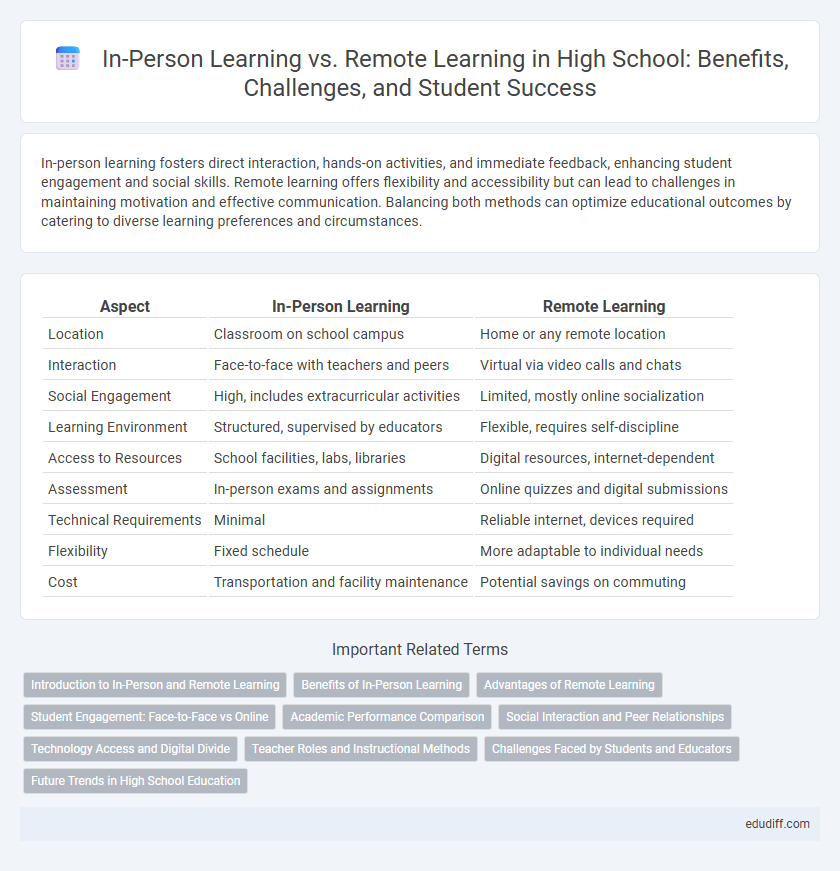In-person learning fosters direct interaction, hands-on activities, and immediate feedback, enhancing student engagement and social skills. Remote learning offers flexibility and accessibility but can lead to challenges in maintaining motivation and effective communication. Balancing both methods can optimize educational outcomes by catering to diverse learning preferences and circumstances.
Table of Comparison
| Aspect | In-Person Learning | Remote Learning |
|---|---|---|
| Location | Classroom on school campus | Home or any remote location |
| Interaction | Face-to-face with teachers and peers | Virtual via video calls and chats |
| Social Engagement | High, includes extracurricular activities | Limited, mostly online socialization |
| Learning Environment | Structured, supervised by educators | Flexible, requires self-discipline |
| Access to Resources | School facilities, labs, libraries | Digital resources, internet-dependent |
| Assessment | In-person exams and assignments | Online quizzes and digital submissions |
| Technical Requirements | Minimal | Reliable internet, devices required |
| Flexibility | Fixed schedule | More adaptable to individual needs |
| Cost | Transportation and facility maintenance | Potential savings on commuting |
Introduction to In-Person and Remote Learning
In-person learning at high schools offers direct interaction between students and teachers, fostering immediate feedback and social engagement essential for collaborative activities. Remote learning utilizes digital platforms to deliver lessons online, providing flexibility but often requiring strong self-discipline and reliable technology access. Both methods impact student performance differently, influenced by factors such as learning styles, accessibility, and resource availability.
Benefits of In-Person Learning
In-person learning enhances student engagement through face-to-face interaction, fostering better communication skills and immediate feedback from teachers. Access to hands-on activities and collaborative group work supports deeper understanding and social development critical for high school students. The structured environment of in-person classes promotes discipline and consistent study habits, contributing to improved academic performance.
Advantages of Remote Learning
Remote learning offers high school students flexible schedules, enabling personalized pacing that accommodates diverse learning styles and extracurricular commitments. Access to digital resources and interactive online platforms enhances engagement and supports a variety of multimedia learning experiences. The reduction of commute time and a controlled home environment contribute to increased focus and overall academic performance.
Student Engagement: Face-to-Face vs Online
In-person learning fosters higher student engagement through real-time interactions, immediate feedback, and social collaboration essential for high school development. Remote learning often challenges maintaining consistent student participation due to distractions and limited physical presence despite the use of digital tools. Effective engagement strategies in online settings require tailored approaches like interactive platforms and synchronous sessions to simulate face-to-face dynamics.
Academic Performance Comparison
Studies reveal that in-person learning enhances academic performance through direct teacher interaction and immediate feedback, fostering better comprehension and engagement. Remote learning often challenges students with distractions and limited real-time support, which can lower achievement in subjects requiring hands-on practice or collaborative work. Data from multiple school districts indicate higher test scores and lower dropout rates in traditional classrooms compared to virtual environments.
Social Interaction and Peer Relationships
In-person learning fosters essential social interaction and peer relationships that are crucial for high school students' emotional development and collaborative skills. Face-to-face classrooms enable spontaneous discussions, group activities, and nonverbal communication, enhancing students' ability to build meaningful connections. Remote learning environments often limit these interactions, potentially impacting students' social competence and sense of community.
Technology Access and Digital Divide
In-person learning offers equal access to school-provided technology, minimizing disparities caused by socioeconomic status. Remote learning often exacerbates the digital divide, as students without reliable internet or adequate devices face significant barriers to participation. Ensuring technology equity is essential to prevent learning loss and promote academic success in remote education environments.
Teacher Roles and Instructional Methods
In-person learning allows high school teachers to employ interactive, hands-on instructional methods that foster real-time student engagement and immediate feedback. Remote learning requires educators to adapt by using digital tools and asynchronous techniques that emphasize self-paced study and virtual collaboration. Both modalities demand teachers to balance content delivery with student support, but in-person settings facilitate stronger relational dynamics and spontaneous problem-solving opportunities.
Challenges Faced by Students and Educators
In-person learning challenges include limited classroom space and managing diverse student needs, while remote learning presents obstacles such as technological accessibility and maintaining student engagement. Educators face difficulties adapting lesson plans for virtual platforms and providing timely feedback, whereas students struggle with distractions and lack of social interaction. Both environments require innovative strategies to overcome these barriers and ensure effective education outcomes.
Future Trends in High School Education
Future trends in high school education emphasize a hybrid model combining in-person learning with advanced remote learning technologies, enhancing accessibility and personalized instruction. Artificial intelligence and virtual reality tools are expected to play a significant role in creating immersive educational experiences and real-time feedback. Schools increasingly adopt data-driven approaches to optimize student engagement and academic outcomes while preparing learners for a digitally connected world.
In-Person Learning vs Remote Learning Infographic

 edudiff.com
edudiff.com